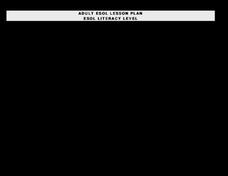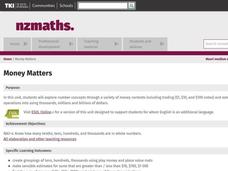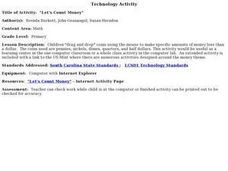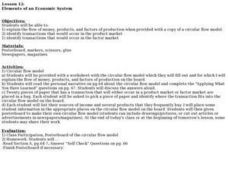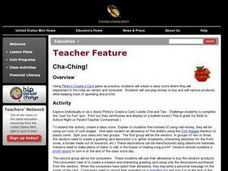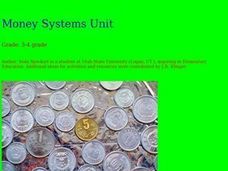Curated OER
ADULT ESOL LESSON PLAN--Level 2--Time and Money
Students , while daily reviewing the vocabulary terms on the board, identify and practice writing ordinal and cardinal numbers and know when to use them correctly. In addition, students are asked to share ordinal and cardinal numbers in...
Curated OER
ESOL: Time and Money
Students study time and money. They read and practice cardinal numbers using numerals and words. They collaborate in apirs and exchange flashcards identifying cardinal numbers 0-10. They complete an activity sheet and show pictures and...
Curated OER
ESOL: Time and Money
Young scholars study the parts of an analog and digital clock. They create paper clocks to identify telling time to the hour, half-hour, and quarter past and quarter after. They practice tellng time in pairs.
Curated OER
Math -- Money
Students identify a penny, nickel, dime, quarter and a half dollar. They examine the value of each coin and its equivalents (to quarter/dollar). After pairing up with a classmate, each one drills the other one on each coin.
Curated OER
Money Matters
Third graders make fair trades and exchanges of their money in order to have practical experiences with the essential "rules" of our place value system. They create groupings of tens, hundreds, thousands using play money and place value...
Curated OER
Playing with Money (From the New Zealand Point of View)
Students explore the exchange rates for five countries. They identify the units of currency of a number of countries. Students convert money amounts accurately from New Zealand dollars to another currency. They graph currency...
Curated OER
Playing with Money (From the Other Point of View)
Students explore exchange rates. They identify the units of currency of a number of countries. Students convert money amounts accurately. They graph currency fluctuations and interpret graphs.
Curated OER
"Let's Count Money"
Young scholars participate in an interactive Internet activity that allows them to practice counting money. Students can work independently or cooperatively as they "drag and drop" coins using a mouse.
Curated OER
Elements of an Economic System
High schoolers review the elements of an economic system. Using a circular flow model, they explain the flow of money, products and factors of production. They identify transactions that would occur in the product and factor markets.
Curated OER
Money as a Means of Exchange
First graders discover the term bartering as used to pay for wanted items. They play a bartering game to discover exchanging goods for wanted items and play the computer money game on the "Show-Me Economics" web site.
Curated OER
Cha-Ching!
Students play the Pinky's Create a Card game for practice. Students create a class store where they experiment in the roles as vendor and consumer. Students use play money to buy and sell various products, while keeping track of spending...
Curated OER
Money Matters!
Students get to build a piggy bank and experiment with coin denominations. Students gather parents and community volunteers to join with them for this class art project. Students and volunteers papier-mache an original piggy bank.
Curated OER
Saving and Spending
Students identify the reasons why they believe people save money. After this list, they discuss what they spend their money on and determine if the reasons for saving money change over time. In groups, they use the story of "Uncle Jed's...
Curated OER
Pocket Money And Pester Power
Students participate in a number of activities to examine how young people think about, use and make money. They determine what young people prefer to spend money on, if there are gender differences and how they compare to students in...
Curated OER
Money Systems
Students examine how paper money and coins have changed over time. They discuss different types of exchanging items for payment. They practice making change.
Curated OER
Money Talks Canadian Money
Students use newspapers, games and journal writing activities to examine the importance of money and the role it plays in daily life. They complete several math problems, fill out worksheets and practice changing varying amounts.
Curated OER
Managing Your Money
Students use the internet to gather information on saving money. They describe the history of money and the responsibilities of the United States Mint. They list their own personal goals and keep a journal as they operate a lemonade...
Curated OER
Lesson 3: Where Does Money Come From?
Students listen to story Hundred Penny Box by Sharon Bell Mathis, explore history of money, and examine how money is produced in the United States. They discuss why money is used for exchange, and describe how money has changed over time.
Curated OER
Teaching Money
Students identify the coins and bills used in the United States. They write the amounts of each bill and coin and practicing counting different amounts. They follow a demonstration about how to count money as well.
Curated OER
Spend, Save or Donate
Young scholars identify the difference between spending, saving, and donating. They brainstorm reasons to give and options to donate. They sing a song about donating to charity.
Curated OER
All About Money Curriculum
Learners participate in different pre-lessons to examine the role of individuals and neighborhoods. They also discover the role of the IMF and nations around the world.
Curated OER
Money Matters Curriculum
Students complete a concept map on how money matters in our society. They use the internet to discover an online exhibit about money. They also complete a concept map.
Curated OER
The IMF, Money, International Trade and Cooperation
Young scholars study the role of the International Money Fund and develop an understanding of international trade. They investigate learning in a cooperative atmosphere.
Curated OER
Does Money Talk?
Students describe role that money plays in politics, and write an editorial that explains whether or not they think money gives some people too much influence in government.




